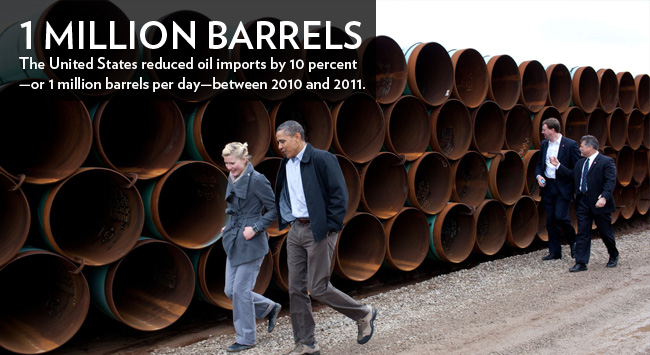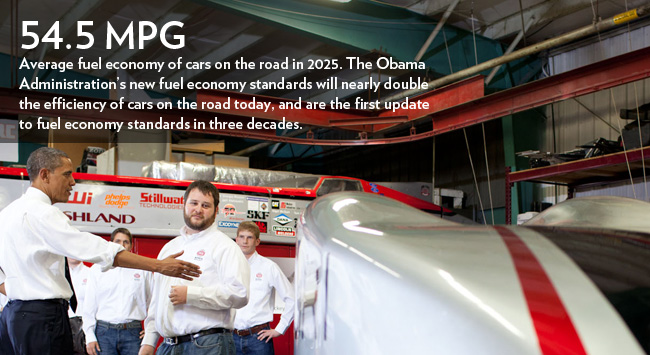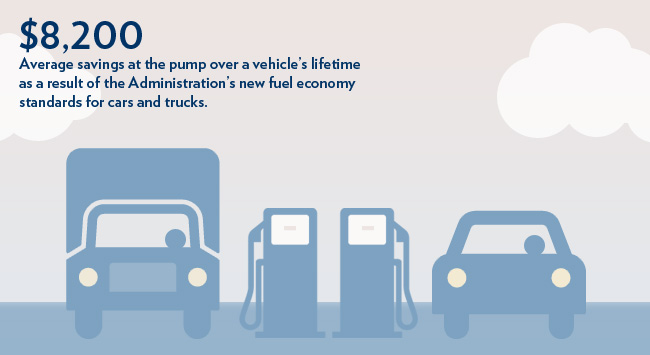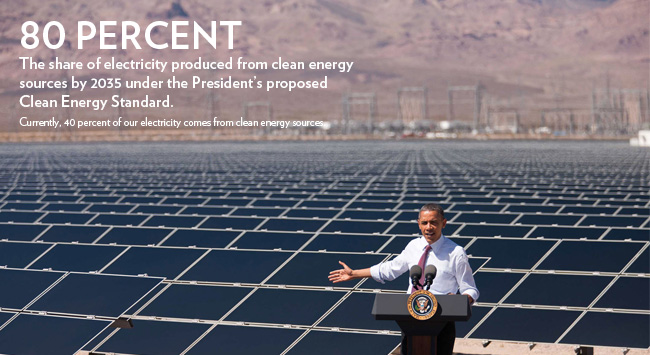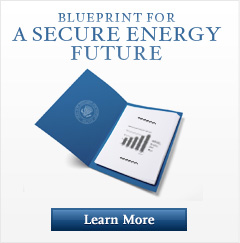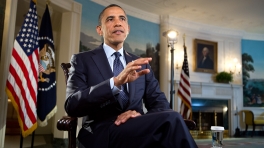Securing American Energy
Develop and Secure America's Energy Resources
We need to deploy American assets, innovation, and technology so that we can safely and responsibly develop more energy here at home and be a leader in the global energy economy.

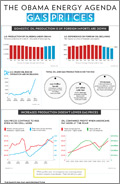
The Obama Energy Agenda and Gas Prices
View the Graphic
Safe and Responsible Domestic Oil and Gas Production
Domestic oil and natural gas production has increased every year President Obama has been in office. In 2011, American oil production reached the highest level in nearly a decade and natural gas production reached an all-time high. In addition, in response to the Deepwater Horizon oil spill in the Gulf of Mexico, the Obama Administration has launched the most aggressive and comprehensive reforms to offshore oil and gas regulation and oversight in U.S. history to ensure that our nation can safely and responsibly expand development of offshore energy resources. The Administration is also taking steps to ensure we can safely develop our vast supplies of domestic natural gas.

Increasing American Energy Independence
Since President Obama took office, America’s dependence on foreign oil has decreased every year. In 2010, the United States imported less than half of all oil consumed – a first in 13 years. In fact, net imports as a share of total consumption declined from 57 percent in 2008 to 45 percent in 2011 – the lowest level in 16 years. In the last year alone, we have cut net oil imports by 10 percent – a million barrels per day.

Provide Consumers with Choices to Reduce Costs and Save Energy
Volatile gasoline prices reinforce the need for innovation that will help consumers save money and protect the environment by driving more advanced and fuel-efficient vehicles, using alternative means of transportation, and making their homes and workplaces more energy efficient.

More Efficient Cars and Trucks
Since taking office, President Obama has made critical investments in advanced vehicle and fuel technologies, public transit, and high speed rail. The Obama Administration has proposed the toughest fuel economy standards for passenger vehicles in U.S. history, requiring an average performance equivalent of 54.5 miles per gallon by 2025. Over time, these new standards will save consumers more than $8,000 in lower fuel costs by doubling the fuel efficiency of our cars and light trucks. The Administration has also finalized the first-ever national fuel economy and greenhouse gas emission standards for commercial trucks, vans, and buses for model years 2014-2018. These standards are projected to save over 500 million barrels of oil and save vehicle owners and operators an estimated $50 billion in fuel costs.
By 2015, because of the investments made by the Obama Administration, the United States will be able to produce enough batteries and components to support the manufacture of one million plug-in hybrid and electric vehicles. The Administration is also carrying out research and development that is aimed at increasing the use of natural gas in transportation and reduce our dependence on oil. Finally, in 2010, President Obama set a goal of breaking ground on at least four commercial scale cellulosic or advanced biorefineries by 2013. That goal has been accomplished, a year ahead of schedule.
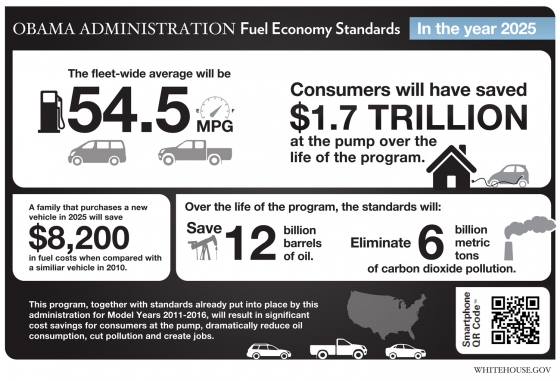
More Efficient Homes, Buildings, and Factories
The Administration’s ongoing energy efficiency agenda crosses sectors. Since October 2009, the Department of Energy and the Department of Housing and Urban Development have jointly completed energy upgrades in more than one million homes across the country. For many families, these upgrades save over $400 on their heating and cooling bills in the first year alone. Through the President’s Better Buildings Challenge, we are working to improve the energy efficiency of commercial buildings by 20 percent by 2020. The Administration has also partnered with manufacturing companies, representing over 1,400 plants, to improve energy efficiency by 25 percent over 10 years.If this performance were achieved by the entire U.S. manufacturing sector over the next decade, savings in total energy costs could exceed $100 billion.
Innovate Our Way to a Clean Energy Future
Leading the world in clean energy is critical to strengthening the American economy and winning the future. We can get there by creating markets for innovative clean technologies that are ready to deploy, and by funding cutting-edge research to produce the next generation of technologies.

America’s Clean Energy Potential
Clean Energy Research & Development
Staying on the Cutting-Edge
In 2009, the Administration funded the Department of Energy’s Advanced Research Project Agency-Energy (ARPA-E) for the first time ever, which focuses on “out-of-the-box” transformational energy research that brings together our nation’s best scientists, engineers, and entrepreneurs. Building upon the initial investment, in late September 2011, the ARPA-E program announced 60 cutting-edge research projects in 25 states. In total, The ARPA-E has supported more than 120 individual projects.
Clean Energy Innovation Hubs
To unleash American innovation, the Administration has launched a series of clean energy innovation hubs, which bring together teams of the best researchers and engineers in the United States to solve major energy challenges. The hubs will focus on improving batteries and energy storage, reducing constraints from critical materials, developing fuels that can be produced directly from sunlight, improving energy efficient building systems design, and using modeling and simulation for advanced nuclear reactor operations.
Leading by Example
Federal Government
President Obama believes that as the largest energy consumer in the U.S. economy, the Federal government has an obligation to lead by example when it comes to its environmental, energy and economic performance. To underscore this commitment, President Obama signed an Executive Order on Federal sustainability that directs Federal agencies to reduce greenhouse gas pollution, meet a number of energy, water, and waste reduction targets, improve the efficiency of vehicle fleets, and leverage Federal purchasing power to promote environmentally-responsible products and technologies. Agencies have begun releasing annual sustainability plans describing the steps they are taking to meet these goals.
Learn More About the Executive Order on Federal Sustainability
The U.S. Military
As part of the President's commitment to a strong national defense, the Department of Defense (DoD) is harnessing energy efficiency and new energy technologies to give our troops better energy options on the battlefield, at sea, in the air, and at home. DoD is investing in better aircraft engines, hybrid electric drives for ships, improved power for patrol bases in Afghanistan, and higher building efficiency at facilities worldwide. The Department of Navy has also committed to adding 1 gigawatt of renewable energy produced from sources like solar, wind, and geothermal to its energy supply for shore-side installations – enough to power 250,000 homes. To guide future investments and policy, the Operational Energy Strategy Implementation Plan, released in March 2012, serves as a roadmap to transform the way the Department uses energy in military operations.
Recent News
- February 14, 2013 at 11:00 AM EST
Reducing Pollution For All American Families
Outgoing EPA Administrator Lisa P. Jackson cites the importance of environmental justice for all Americans.
- February 13, 2013 at 7:00 PM EST
Open for Questions: The State of the Union and Energy and the Environment
Heather Zichal, Deputy Assistant to the President for Energy and Climate Change, answers questions from the public about the President’s speech in an “Open for Questions” session moderated by Popular Science.
- February 11, 2013 at 9:23 PM EST
State of the Union 2013: White House “Open for Questions” Marathon
In the days following the State of the Union Address, Administration officials will take questions on key issue areas addressed in the President's speech submitted by the public on social media during an "Open for Questions" marathon.






